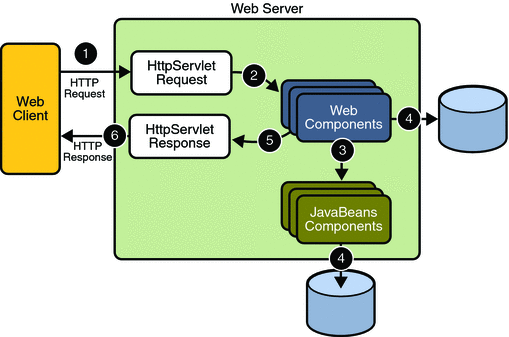Overview of Web Application Security
In the Java EE platform, web components provide the dynamic extension capabilities for a web server. Web components are either Java servlets, JSF pages, or web service endpoints. The interaction between a web client and a web application is illustrated in Figure 25–1.
Figure 25–1 Java Web Application Request Handling

Web components are supported by the services of a runtime platform called a web container. A web container provides services such as request dispatching, security, concurrency, and life-cycle management. Certain aspects of web application security can be configured when the application is installed, or deployed, to the web container. Annotations and/or deployment descriptors are used to relay information to the deployer about security and other aspects of the application. Specifying this information in annotations or in the deployment descriptor helps the deployer set up the appropriate security policy for the web application. Any values explicitly specified in the deployment descriptor override any values specified in annotations.
Security for Java EE web applications can be implemented in the following ways:
-
Declarative security can be implemented using either an application's deployment descriptor or using metadata annotations. Metadata annotations (or simply, annotations) are used to specify information about security within a class file. An application deployment descriptor is an XML file that is external to the application and which expresses an application’s security structure, including security roles, access control, and authentication requirements. When an application is deployed, security information specified using annotations can be overridden by the application deployment descriptor.
Declarative security is described in Using Deployment Descriptors to Secure Web Applications.
-
Programmatic security is embedded in an application and is used to make security decisions. Programmatic security is useful when declarative security alone is not sufficient to express the security model of an application. Declarative security alone may not be sufficient in cases where conditional login in a particular work flow, instead of for all cases, is required in the middle of an application.
New in Java EE 6 and Servlet specification 3.0 are the authenticate, login, and logout, methods of the HttpServletRequest interface. With the addition of the authenticate, login, and logout methods to the Servlet specification, an application deployment descriptor is no longer required for web applications, but may still be used to further specify security requirements beyond the basic default values.
Programmatic security is discussed in Using Programmatic Security with Web Applications
-
Message security works with web services and incorporates security features, such as digital signatures and encryption, into the header of a SOAP message, working in the application layer, ensuring end-to-end security. Message security is not a component of Java EE 6, but is included here for informational purposes only.
Message security is discussed in Using Message Security with Web Applications.
Some of the material in this chapter builds on material presented earlier in this tutorial. In particular, this chapter assumes that you are familiar with the information in the following chapters:
- © 2010, Oracle Corporation and/or its affiliates
